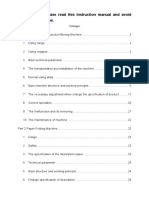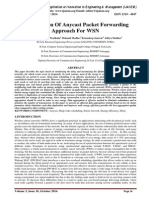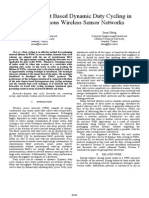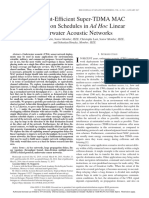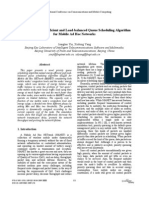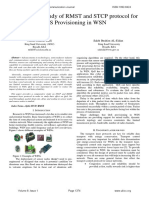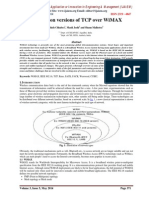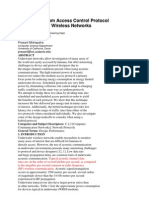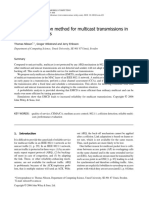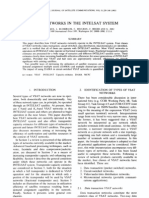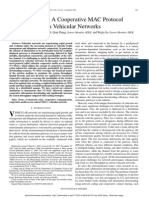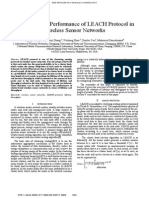DW-MAC: A Low Latency, Energy Efficient Demand-Wakeup MAC Protocol For Wireless Sensor Networks
DW-MAC: A Low Latency, Energy Efficient Demand-Wakeup MAC Protocol For Wireless Sensor Networks
Uploaded by
jeevithaCopyright:
Available Formats
DW-MAC: A Low Latency, Energy Efficient Demand-Wakeup MAC Protocol For Wireless Sensor Networks
DW-MAC: A Low Latency, Energy Efficient Demand-Wakeup MAC Protocol For Wireless Sensor Networks
Uploaded by
jeevithaOriginal Title
Copyright
Available Formats
Share this document
Did you find this document useful?
Is this content inappropriate?
Copyright:
Available Formats
DW-MAC: A Low Latency, Energy Efficient Demand-Wakeup MAC Protocol For Wireless Sensor Networks
DW-MAC: A Low Latency, Energy Efficient Demand-Wakeup MAC Protocol For Wireless Sensor Networks
Uploaded by
jeevithaCopyright:
Available Formats
DW-MAC: A Low Latency, Energy Efficient Demand-Wakeup
MAC Protocol for Wireless Sensor Networks
Yanjun Sun
Shu Du
Omer Gurewitz
yanjun@cs.rice.edu
dushu@cs.rice.edu
gurewitz@cse.bgu.ac.il
David B. Johnson
dbj@cs.rice.edu
Department of Computer Science, Rice University, Houston, TX, USA
Department of Communication Systems Engineering, Ben Gurion University, Israel
ABSTRACT
1. INTRODUCTION
Duty cycling is a widely used mechanism in wireless sensor networks (WSNs) to reduce energy consumption due to idle listening,
but this mechanism also introduces additional latency in packet delivery. Several schemes have been proposed to mitigate this latency,
but they are mainly optimized for light traffic loads. A WSN, however, could often experience bursty and high traffic loads, such as
due to broadcast or convergecast traffic. In this paper, we present
a new MAC protocol, called Demand Wakeup MAC (DW-MAC),
that introduces a new low-overhead scheduling algorithm that allows nodes to wake up on demand during the Sleep period of an
operational cycle and ensures that data transmissions do not collide at their intended receivers. This demand wakeup adaptively
increases effective channel capacity during an operational cycle as
traffic load increases, allowing DW-MAC to achieve low delivery
latency under a wide range of traffic loads including both unicast
and broadcast traffic. We compare DW-MAC with S-MAC (with
and without adaptive listening) and with RMAC using ns-2 and
show that DW-MAC outperforms these protocols, with increasing
benefits as traffic load increases. For example, under high unicast
traffic load, DW-MAC reduces delivery latency by 70% compared
to S-MAC and RMAC, and uses only 50% of the energy consumed
with S-MAC with adaptive listening. Under broadcast traffic, DWMAC reduces latency by more than 50% on average while maintaining higher energy efficiency.
Wireless sensor networks (WSNs) have a significant potential in
applications interacting with the physical world, such as surveillance and environmental monitoring. In many of these applications, the use of battery-powered sensor nodes greatly eases the deployment of the network, but the limited capacity of these batteries
substantially limits the network lifetime.
One of the largest sources of energy consumption in wireless
nodes is the use of idle listening, and many solutions to reducing
this problem in WSNs have been proposed based on the use of duty
cycling [20, 27]. In duty cycling, sensor nodes periodically alternate between being active and sleeping. When active, a node is
able to transmit or receive data, whereas when sleeping, the node
completely turns off its radio to save energy; duty cycles of 110%
(percentage of time in the active state) are typical in order to maximize energy savings. In order to transmit a packet from one node
to another, the radios of both nodes must be on, motivating the
use of synchronization between the operational cycles of different
nodes. Examples of protocols using synchronized approaches include S-MAC [26, 27], T-MAC [4], and RMAC [5].
For example, in S-MAC [27] time at each sensor is divided into
repeated operational cycles, each further divided into three periods: Sync, Data, and Sleep. Nodes in S-MAC wake up at the start
of the Sync period to synchronize clocks with each other. During
the Data period, all nodes remain active. If a node has a packet
to send to a neighbor node, they exchange Request-to-Send (RTS)
and Clear-to-Send (CTS) frames during the Data period, followed
by the transmission of the data packet and the return of an Acknowledgement (ACK) frame. Nodes not involved in communication initiated during the Data period return to the sleep state at the
start of the Sleep period; other nodes return to the sleep state only
after completion of the ACK frame.
Although such approaches save energy, they can add significant
latency in packet delivery, since transmission of a packet from one
node to a neighbor node must wait until the next time the nodes are
active, if the nodes are currently sleeping. Furthermore, forwarding
a packet over multiple wireless hops, as is common in WSNs, often
requires multiple operational cycles to complete.
Several approaches have be proposed to mitigate the additional
latency introduced by duty cycling [4, 5, 26], but they are mainly
optimized for light traffic loads. A WSN, however, could often experience bursty and high traffic loads. For example, either broadcast [18] or convergecast [29] traffic could suddenly increase channel contention in a local neighborhood. In WSNs, broadcast is
widely used for various network-wide queries and updates [24],
and convergecast is often observed when multiple sensors that have
detected the same event send their reports to the sink node or to a
node that does data aggregation [7].
Categories and Subject Descriptors
C.2.2 [Computer-Communication Networks]: Network
Protocols; C.2.5 [Computer-Communication Networks]: Local
and Wide-Area NetworksAccess Schemes
General Terms
Algorithms, Design, Performance
Keywords
Sensor networks, medium access control, duty cycling, unicast
traffic, broadcast traffic, latency, energy
Permission to make digital or hard copies of all or part of this work for
personal or classroom use is granted without fee provided that copies are
not made or distributed for profit or commercial advantage and that copies
bear this notice and the full citation on the first page. To copy otherwise, to
republish, to post on servers or to redistribute to lists, requires prior specific
permission and/or a fee.
MobiHoc08, May 2630, 2008, Hong Kong SAR, China.
Copyright 2008 ACM 978-1-60558-073-9/08/05 ...$5.00.
53
As existing approaches are mainly optimized for light traffic
loads, we found that they become less efficient in latency, power
efficiency, and packet delivery ratio (fraction of data packets successfully delivered) as traffic load increases. As traffic in a WSN
can be quite dynamic, depending on the events being sensed and the
sensing application and protocols being used, an ideal WSN MAC
protocol should perform well under a wide range of traffic loads,
including high loads and bursty traffic.
In this paper, we present a new MAC protocol, called Demand
Wakeup MAC (DW-MAC), that introduces a new low-overhead
scheduling algorithm that allows nodes to wake up on demand during the Sleep period of an operational cycle in order to transmit or
receive a packet. This demand wakeup adaptively increases effective channel capacity during an operational cycle as traffic load increases, allowing DW-MAC to achieve low delivery latency under
a wide range of traffic loads including both unicast and broadcast
traffic.
DW-MAC differs from prior work in reducing the additional latency introduced by duty cycling. In DW-MAC, medium access
control and scheduling are integrated, in that during a Data period
of an operational cycle, the interval of time during which the transmission of an access control frame occupies the medium automatically reserves the proportional interval of time in the following
Sleep period for transmitting and receiving a data packet. This integration minimizes scheduling overhead and collisions. Further,
by avoiding transmission of data packets in a Data period, DWMAC maximizes the number of access control frames that can be
exchanged in a Data period, thus increasing the number of data
packets that can be exchanged in a complete operational cycle. The
contributions of this work are as follows:
R C DATA A
R C DATA A
C
C
Sync
Wake up at end of transmission
indicated by received CTS
R C DATA A
time
R C DATA A
Data
Transmit
Sleep
Receive
R : RTS C : CTS A : ACK
Active radio
Figure 1: S-MAC with adaptive listening.
for a short time when the overheard communication finishes; if this
node is the next-hop node along a multi-hop path, its neighbor can
forward the packet immediately to this node rather than waiting for
the Data period in the next operational cycle to initiate the forwarding. Figure 1 shows an example of the operation of S-MAC with
adaptive listening. Node A here sends a data packet to node B, with
a next-hop node of C. When node C overhears the CTS from B, it
goes to sleep but wakes up again when the ACK from B should
have been completed, based on the information in the overheard
CTS. Node B can immediately forward the data packet to C at this
time.
S-MAC with adaptive listening can deliver a packet up to 2 hops
per operational cycle but generally cannot go beyond that within the
cycle since the next hop after C (such as some node D) is unlikely
to have been awake to overhear the communication from B to C;
node C will transmit an RTS to D but will go back to sleep itself
when it fails to receive a CTS in reply from D. The use of adaptive listening can also cause a significant increase in energy consumption, since many neighboring nodes may overhear the RTS
or CTS and wake up, whereas only one of them is the next-hop
node. Moreover, since a node does not wake up until an overheard
communication ends, this node then may not have complete knowledge of the busy state of the wireless medium. For example, the
node might have missed hearing an RTS or CTS of another data
transmission in the neighborhood; if the node in this case starts
transmitting any packet, the packet may cause collisions at other
nodes.
Similarly, T-MAC [4] can reduce latency by adaptively changing
the ending time of a Data period. Although T-MAC is primarily
designed to shorten the Data period when no traffic is around the
node, so that nodes can preserve more energy, T-MAC can also
extend the Data period to allow multihop forwarding during a single Data period. However, as with S-MAC with adaptive listening,
T-MAC can generally deliver a packet over only at most 2 hops
within an operational cycle, since nodes further downstream will
be unlikely to overhear the upstream communication 2-hops away
and thus will not remain awake to receive a forwarded packet; TMAC may also increase energy consumption, as many nodes other
than an intended next-hop node will remain awake.
Several other approaches to reducing latency have been proposed, that make specific assumptions on the communication pattern among nodes or on the other protocols used in the WSN. For
example, DMAC [15] reduces latency only for data gathering communication in which multiple nodes try to send data to a sink node
through a unidirectional tree of paths. Likewise, the streamlined
wakeup optimization proposed by Cao et al. [2] address only the
case in which each sensor node sends data to a sink node (although
there may be more than one sink node for the network). For a network of tree topology or ring topology, Lu et al. [16] discuss how to
minimize end-to-end latency. The work of Keshavarzian et al. [11]
analyzes latency for specific communication and wakeup patterns
for communication with the sink node and proposed the multi-
We introduced a new low overhead scheduling algorithm that
ensures that data transmissions do not collide at their intended receivers.
We present the design of DW-MAC that wakes up nodes on
demand in order to efficiently handle a wide range of traffic
load including both unicast and broadcast traffic.
DW-MAC wakes up a node in a Sleep period only when the
node needs to transmit or receive a packet, in order to minimize energy consumption.
DW-MAC achieves lower latency, higher power efficiency,
and higher packet delivery ratio compared to existing schemes.
The rest of this paper is organized as follows. In Section 2, we
discuss related work in approaches to reducing latency in synchronized duty cycle MAC protocols for WSNs. Section 3 presents
the detailed design of DW-MAC, including support for both unicast and broadcast traffic and for optimized multihop forwarding.
Section 4 presents results from our simulation-based evaluation of
DW-MAC, including a comparison with S-MAC (with and without
adaptive listening) and with RMAC, and finally, in Section 5, we
present conclusions.
2.
RELATED WORK
A number of previous approaches to reduce latency in synchronized
duty cycle MAC protocols for WSNs have been proposed, although
none provides the generality or performance of our DW-MAC approach. We discuss these previous approaches here.
S-MAC [27] was one of the original synchronized duty cycle
MAC protocols for WSNs, and the developers of S-MAC later introduced a modification known as adaptive listening [26] to improve its end-to-end delivery latency over multiple hops. With
adaptive listening, if a node overhears another nodes communication (e.g., the RTS or CTS) during the Data period, it wakes up
54
scheduling frame (SCH)
P P
P P P DATA A DATA A
PP
C
Sync
DATA A
time
S
T3
DATA A
Data
T1
Sync
Sleep
Figure 2: Multihop forwarding of a unicast packet in RMAC.
P indicates a PION frame that is used for scheduling.
T2
wake up to transmit data packet
T4
wake up to receive data packet
Data
Sleep
TData
TSleep
DW-MAC proportional mapping:
T3
TData
T1
=
=
T2
T4
TSlee p
Figure 3: Overview of scheduling in DW-MAC.
parent technique to improve performance under the assumption that
nodes at higher levels in the communication tree have more than a
single neighbor and thus can have more than a single parent. In
contrast to each of these protocols, DW-MAC supports arbitrary
communication between any nodes, whether to a sink node or to
the other peer nodes such as to facilitate in-network processing of
sensor data. The fast path algorithm proposed by Li et al. [14] also
supports arbitrary communication patterns but assumes that such
fast paths are long-lived and are set up through the routing protocol; DW-MAC makes no such assumptions and supports arbitrary
communication between nodes at any time without relying on other
protocols for assistance.
RMAC [5] represents a different approach to reducing latency
in multihop forwarding; an example of the operation of RMAC is
illustrated in Figure 2. In RMAC, a control frame, called a Pioneer
frame (PION), is forwarded over multiple hops (e.g., A B C)
during a Data period in order to inform nodes B and C when to
wake up during the Sleep period to receive or transmit the corresponding data packet. The number of hops over which RMAC can
forward a data packet during an operational cycle is limited by the
duration of the Data period but may be set to any value depending on the parameters used. However, as a source node always
starts transmitting a data packet at the beginning of a Sleep period
(e.g., node A in Figure 2), two hidden sources that have succeeded
in scheduling through PIONs in a Data period always cause collisions at the beginning of the next Sleep period. In addition, a node
waken up due to a previous PION will wake up unnecessarily if
the expected data packet cannot arrive due to collisions at previous
hops.
The scheduling mechanism in DW-MAC ensures that data transmissions do not collide at their intended receivers, and many other
techniques for collision-free transmission in WSNs have been studied by others (e.g., [12, 22]). However, in contrast to these techniques, DW-MAC is a contention-based protocol that integrates
medium access control and scheduling seamlessly. Furthermore,
DW-MAC supports not only unicast communication but also broadcast communication. Many other techniques for efficient broadcast
communication in wireless sensor networks and in wireless ad hoc
networks have been studied (e.g., [7,19,19,21,24,25]). However, in
contrast to these techniques, a node in DW-MAC wakes up on demand during a Sleep period; scheduling frames during the Data period explicitly coordinate nodes when to wake up during the Sleep
period to transmit or receive a packet.
sensor nodes during the Sync period with required precision. The
basic concept of DW-MAC is to wake up nodes on demand during
the Sleep period of a cycle in order to transmit or receive a packet.
This demand wakeup adaptively increases effective channel capacity during a cycle as traffic load increases, allowing DW-MAC to
achieve low delivery latency under a wide range of traffic loads
including both unicast and broadcast traffic.
DW-MAC is unique in the way it schedules nodes to wake up
during the Sleep period of a cycle. In DW-MAC, medium access control and scheduling are fully integrated. In a Data period, a node with pending data contends for channel access using
a CSMA/CA protocol as in IEEE 802.11. DW-MAC, however, replaces RTS/CTS with a special frame called a scheduling frame
(SCH). The interval of time during which the transmission of a
SCH occupies the wireless medium automatically and uniquely reserves the proportional interval of time in the following Sleep period for transmitting and receiving the pending data packet. Essentially, DW-MAC sets up a one-to-one mapping between a Data
period and the following Sleep period. An SCH carries no timing information, and the transmission of an SCH simply replaces
that of RTS/CTS for medium access control. In this way, DWMAC minimizes scheduling overhead. As in an RTS, an SCH
contains the destination address, so this SCH wakes up only the
intended receiver, minimizing energy consumption due to unnecessary wake-ups. Furthermore, this integration ensures that data
transmissions do not collide at their intended receivers as discussed
below.
Figure 3 shows an overview of scheduling in DW-MAC based
on this one-to-one mapping between a Data period and the following Sleep period. In this example, node A wants to transmit a data
packet to node B. Node A first contends for channel access and
transmits an SCH during the Data period. Suppose transmission
of the SCH starts T1 time units after the beginning of the Data period. Based on T1 and the duration of the SCH transmission, T3 ,
nodes A and B will both schedule their wakeup time to T2 from
the beginning of the following Sleep period, and will agree on a
maximum wakeup duration of T4 , based on the ratio between TData
and TSleep , as shown in the figure. If the packet to be transmitted is a unicast packet, node B will return a confirmation SCH
frame (not in the figure) SIFS delay after receiving the request
SCH from A; if the packet is a broadcast packet, node B takes no
further action. When nodes A and B both wake up at the agreed
time, node A transmits the actual data packet, which can be either
broadcast or unicast. In case of unicast packet, node B acknowledges the successful receipt of the packet with an ACK. Although
we show the scheduling for only one pair of nodes in this example, DW-MAC allows multiple contending nodes to exchange SCH
frames with their intended receivers during a Data period, so that
multiple data transmissions can happen in the following Sleep period.
3. DW-MAC DESIGN
3.1. Overview
DW-MAC is a synchronized duty cycle MAC protocol, where each
cycle is divided into three periods: Sync, Data, and Sleep (Figure 3). We denote the duration of each period by TSync , TData , and
TSleep , respectively. Similar to prior work, DW-MAC assumes that
a separate protocol (e.g., [6, 9]) is used to synchronize the clocks in
55
T1D
3.2. Mapping Function for Scheduling
As previously explained, DW-MAC exploits a contention based
Data period in order to schedule actual data transmissions during
the subsequent Sleep period. To avoid collisions during the Sleep
period, a sender must coordinate with its intended receiver to find
a period of time in the Sleep period during which the neighboring
nodes of both are idle. The challenges in designing such a protocol
are twofold:
minimize message exchanges between a sender, the intended
receiver, and their respective neighbors for schedule negotiation; and
minimize the size of a scheduling frame, e.g., avoid carrying
timing information in a scheduling frame.
DW-MAC meets these challenges by employing a one-to-one
proportional mapping function between time during a Data period
and time during the subsequent Sleep period. With this mapping
function, DW-MAC schedules data transmissions without exchanging any timing information. In order to further understand the Data
to Sleep period mapping, we denote by TiD the time difference between a specific time instance ti in a Data period and the beginning
of that Data period. We further denote by TiS the time difference between the start of the subsequent Sleep period and the corresponding mapped time instance during the Sleep period. Accordingly
DW-MAC defines the following mapping function:
TSleep
TiS = TiD
(1)
TData
By mapping each time instant in a Data period into the subsequent Sleep period, the mapping function scales the time based
on the ratio between TSleep and TData , and hence a time interval
B
Sync
T1S
DATA
DATA
Data
Sleep
Figure 4: Broadcast in DW-MAC.
3.3. Scheduling Frame (SCH)
In addition to the fields included in an RTS/CTS, such as sender
and receiver addresses, and duration of the transmission, an SCH
also includes some cross-layer information. For a broadcast packet,
an SCH includes the network layer address of its source and its sequence number. This information helps a node to decides whether
the incoming broadcast packet has been received before or not, in
order to avoid waking up to receive copies of the same packet multiple times. For a unicast packet, an SCH includes the network
layer address of its final destination. This cross-layer information
enables a node to set up a schedule to the next hop neighbor before
even receiving the actual data packet, as discussed in Section 3.5.
An SCH serves either as a scheduling request or a scheduling
confirmation. For a multihop forwarding, an intermediate node
sends a single SCH serving both purposes: first, this SCH confirms
the received SCH from the upstream node, and second, it schedules
the forwarding of the eventual data packet to the next downstream
node. In order to allow a single SCH to serve either or both of these
two uses, an SCH includes two bits in the header to indicate which
role(s) it is playing. As an access control frame in S-MAC is 10
bytes [26] and the address of a node usually takes two bytes [13],
14 bytes is the size for an SCH to hold the additional cross-layer
information in our simulation.
of T1 time units in the Data period will be mapped into T1 TSleep
Data
time units during the Sleep period. With this mapping function,
a sender and its intended receiver(s) can uniquely determine the
starting point for data packet transmission in a Sleep period from
the starting time of the corresponding SCH transmission during the
previous Data period, without including even a single bit of timing information in the SCH. Furthermore, the difference between
the mapped beginning and end of the SCH transmission determines
the maximum data transmission time. We can state the following
proposition for DW-MAC:
3.4. Broadcast and Unicast in DW-MAC
DW-MAC supports two modes of operation: unicast traffic and
broadcast traffic.
Broadcast of a data packet in DW-MAC is illustrated in Figure 4.
After successfully transmitting an SCH, a sender (node A) starts
broadcasting the packet at the time calculated based on the mapping
function (Equation 1), T1S in this example. Based on the source address and the sequence number of the packet, which are included in
the SCH, each receiver decides whether it has received the packet
before. In case the packet has already been received by this node,
the SCH is ignored. Otherwise, the receiver sets up a wakeup time
for itself for receiving the corresponding data packet. In this example, node B estimates T1D based on when the SCH is received and
its transmission delay. Using the mapping function, node B sets up
a timer to wake up at T1S after the beginning of the Sleep period.
Note that node B can contend for another SCH transmission and
schedule the rebroadcast of the eventual incoming data packet even
though it has not yet received the packet.
In the case of unicast traffic, a sender transmits an SCH prior
to data transmission as it does for a broadcast packet. However,
DW-MAC requires the intended receiver of the data packet to send
back another SCH, SIFS after the receipt of the SCH, to confirm
the receipt of that SCH. If the confirmation is received in time, the
sender sets up a wakeup time for itself for data transmission. Otherwise, the sender attempts to transmit another SCH later, equivalent
to a retransmission of an RTS. After receipt of a data packet, the
receiver returns an ACK to the sender, SIFS after the completion
of the data. As with the confirmation SCH, if the sender does not
receive the ACK, it attempts to retransmit the data again (begin-
P ROPOSITION: Any receiver that wakes up in a Sleep period is
never in range of two simultaneous data packet transmissions, i.e.,
data transmissions by nodes that wake up during the Sleep period
do not collide at their intended receivers.
P ROOF. We show this by contradiction. Assume that two data
transmissions could collide. In order for data transmissions to collide at a node, they must overlap with each other. Therefore, the
respective SCHs should also overlap at that node during the previous Data period. In this case, that node could not have decoded any
SCH and thus would not wake up during the Sleep period, which
contradicts the assumption.
Note that the proposition only relates to collisions between data
packets. We emphasize that a collision between a data packet and
an ACK is still possible. This collision can be easily avoided by delaying the ACK to the mapped start time of the confirmation SCH
sent from the node that transmits this ACK. However, such dataACK collision is a rare event which requires very specific topology
and timing setup between the nodes involved in the collision. In
our implementation, we require a receiver to immediately acknowledge a data packet, so that both the sender and the receiver could
go to sleep immediately and avoid wasting energy waiting for the
delayed ACK.
56
T1D
T2S
SS
Sync
S S
confirmation SCH frame
S
Sync
T1D
T1S
SS
T2D
S S
C
Sync
Data
DATA A
Data
T3S
DATA
DATA
Sleep
Figure 7: Optimized multihop forwarding of a broadcast
packet. Node B specifies node A as the immediate forwarder,
which rebroadcasts an SCH SIFS after receiving that SCH
from A. Node C rebroadcasts the SCH when its backoff counter
expires.
DATA A
T2S
SS S
DATA
T3D
Figure 5: Unicast in DW-MAC.
DATA
T1S
S S S
Sleep
DATA
T1D
DATA A
Data
T2S
T2D
DATA A
T2D
SIFS
T1S
SS
DATA A
DATA A
Sleep
mized forwarding makes it possible for an SCH and thus the corresponding data packet to reach further nodes in a single cycle than
having all rebroadcasting nodes compete for the medium equally.
Although this reduced randomness could increase collision probability, the improved spatial reuse usually offsets this increase or
even lowers total collision probability, as we reveal in our evaluation in Section 4. Many criteria can be used for choosing an immediate forwarder, such as location, degree, or the number of children
nodes of a neighbor. In our DW-MAC simulation, this optimized
forwarding is used when a broadcast tree of a WSN is available
and a node knows its children nodes height (the number of edges
on the longest downward path to a leaf). For an SCH to be rebroadcast, if the SCH is received from the parent node, a node chooses
the child with greatest height as the immediate forwarder. If this
SCH is received from one child node, the parent node of the SCH
receiver is chosen as the immediate forwarder.
Figure 6: Optimized multihop forwarding of a unicast packet.
Node B sends an SCH to wake up node C at the time indicated
by T2s and confirms the SCH received from node A.
ning with a new SCH) during a later operational cycle. Figure 5
illustrates how node A transmits a unicast packet to node B.
If a sender has more data packets (either broadcast or unicast)
than it is able to send during one operational cycle, those packets
are simply queued and are attempted during the next cycle.
3.5. Optimized Multihop Forwarding
DW-MAC optimizes the timing of transmitting SCH frames in order to maximize the number of hops either a unicast or a broadcast
packet can traverse during a cycle. Figure 6 illustrates the optimized multihop forwarding of a unicast packet. In this example,
node A first sends an SCH to node B in order to set up a schedule
for a pending data packet with final destination of node C. The SCH
contains the network layer address of the final destination C. Upon
receiving this SCH, node B calculates the wake up time T1S and
checks the network layer destination in the SCH. Based on information from the routing layer (e.g., as is done in RMAC), node B
will find that C is the next hop for the incoming packet. In this
case, node B sends another SCH, SIFS after receiving the SCH
from A. This SCH not only confirms the SCH just received from A
but also wakes up C at the time indicated by T2S (both bits described
in Section 3.3 in the header of the SCH are set, indicating that this
SCH is serving both roles). In this way, a unicast packet can traverse x hops by only using x + 1 SCH frames in a cycle, and the gap
between two consecutive SCHs is just SIFS, which suggests more
SCH exchanges in a Data period and more data transmissions in a
cycle. Multihop forwarding in a similar manner is also supported
by RMAC. However, DW-MAC dramatically reduce the collisions
experienced by RMAC due to schedule conflicts, as DW-MAC ensures that two data frame transmissions will not collide with each
other.
DW-MAC can also speed the propagation of a broadcast packet
when some neighbor information is available. The main idea is to
favor the rebroadcast of a broadcast packet along some path in order to shorten delays between rebroadcasts and to improve spatial
reuse. In the SCH a node transmits, the node specifies an immediate forwarder that rebroadcasts the SCH SIFS after receiving the
SCH. In the example illustrated in Figure 7, node A is specified
as the immediate forwarder by node B. Any node other than the
immediate forwarder (e.g., node C) backoffs before rebroadcasting the SCH. Nodes A and C will specify an immediate forwarder
other than B in the SCH they rebroadcast, respectively. This opti-
3.6. Implementation Issues
We choose to put a packet size limit in our DW-MAC implementation, although DW-MAC can support larger packet sizes by increasing the size of SCH frames, or by using variable SCH frame
sizes for variable packet sizes. This design choice is based on the
fact that popular sensor radios usually have a packet size limit. For
example, CC1000 in Mica2 [13] and CC2420 in MicaZ [17] have
a packet size limit of 256 and 128 bytes, respectively. With a low
duty cycle configuration such as is common (and as is used in our
simulations), a small SCH can be mapped to a period long enough
for these packet limits.
Wake up times calculated at the sender and receiver(s) are not
necessarily perfectly aligned due to propagation delay and processing time. However DW-MAC does not require an accurate estimation of the start of a transmission. DW-MAC needs only to ensure
that a receiver wakes up early enough during a Sleep period so that
an incoming packet is not missed, which can be ensured by wakening a receiver time before an estimated arrival time.
In our design of DW-MAC, we currently assume all nodes across
the network are able to synchronize their clocks during the Sync
period. This assumption, however, could be relaxed by only requiring all nodes within different network regions (e.g., clusters)
to synchronize with each other, where the clocks between nodes in
different regions need not be synchronized. Nodes on (or near) the
boundary between one region and another would then need to be
aware of the schedules within each region that they border. Since
DW-MAC is compatible with S-MAC, boundary nodes could also
fall back to using S-MAC.
At extremely low duty cycles, the proportional time for a data
packet based on the size of an SCH frame, as indicated by our
57
Table 1: Networking Parameters
Bandwidth
Tx Power
Rx Power
Idle Power
Sleep Power
SIFS
DIFS
Retry Limit
Duty Cycle
20 Kbps
31.2 mW
22.2 mW
22.2 mW
3 W
5 ms
10 ms
5
5%
Table 2: Duty Cycle Configuration
Channel Encoding Ratio
2
Tx Range
250 m
Carrier Sensing Range
550 m
Contention Window (CW ) 64 ms
Size of RTS/CTS/ACK
10 B
Size of SCH/PION
14 B
Size of Data
100 B
State Transition Power
31.2 mW
State Transition Time
2.47 ms
S-MAC
RMAC
DW-MAC
proportions of the carrier sensing range to the transmission range
are also observed in some state-of-art sensor nodes [1].
In our simulations, we keep the same duty cycle of 5% for SMAC, RMAC, and DW-MAC. The durations for the Sync, Data,
and Sleep periods we used are shown in Table 2. For DW-MAC,
we use the same duty cycle-related parameters that were used in the
evaluation of RMAC in [5] for generating comparable results.
The data packet size used in our simulations was 100 bytes,
although a maximum packet size of 256 bytes is supported by the
CC1000 radios [13] and by the parameters used in our simulations.
To simplify our evaluations, we do not include routing traffic
in the simulations and assume that there is a routing protocol deployed to provide the shortest path between any two nodes. We
also ensure that every network we used in our simulations is a connected network. In addition, we do not include any synchronization
traffic and assume all the nodes in the network have already been
synchronized to use a single wake-up and sleep schedule.
For simulations under unicast traffic, each run contains unicast
packets toward a sink node that are triggered by a series of 500
events, and each average value is calculated from the results of 10
random runs. For simulations under broadcast traffic, each run contains 500 broadcast packets generated by a sink node, and each average value is calculated from the results of 30 random runs. Confidence intervals of the average values are not shown because even
99% confidence intervals are so close to average values that they
overlap with the data point markers.
mapping function (Equation 1), can become unnecessarily long due
to the very large ratio of TData to TSleep . The sender and receiver
nodes, however, are not required to remain awake for entire time
indicated for a data packet. In particular, once the receiver completes receipt of the data packet and has returned the ACK, it may
turn off its radio and go to sleep if desired, saving energy; likewise with the sender, once it receives the ACK. It is also possible
to divide the Sleep period into two smaller periods, such that our
mapping function maps time within the Data period proportionally
only to time within the first portion of the Sleep period; during the
second portion of the Sleep period, all nodes would only sleep. By
choosing the size of these two portions of the Sleep period, the duration of the proportional time for a data packet based on the size of
an SCH can be bounded, regardless of the overall duty cycle. For
example, with duty cycles of a fraction of a percent, nodes could
remain asleep during the entire (long) second portion of the Sleep
period.
4.
TSync (ms) TData (ms) TSleep (ms) Tcycle (ms)
55.2
104.0
3025.8
3185.0
55.2
168.0
4241.8
4465.0
55.2
168.0
4241.8
4465.0
SIMULATION EVALUATION
We evaluated DW-MAC using version 2.29 of the ns-2 simulator,
under both unicast and broadcast traffic. Under unicast traffic, we
compared DW-MAC against S-MAC, S-MAC with adaptive listening, and RMAC. Under broadcast traffic, because broadcast is not
supported in S-MAC with adaptive listening or in RMAC, we compared DW-MAC only against S-MAC, in which a broadcast packet
is transmitted during a Data period without using RTS/CTS [27].
Table 1 summarizes the key networking parameters used in our
simulations. In our simulations, each sensor node has a single
omni-directional antenna, and we use the common ns-2 combined
free space and two-ray ground reflection radio propagation model.
Except for the parameters on radio power consumption above,
which are typical values for Mica2 radios (CC1000) [28], we used
the default settings in the standard S-MAC simulation module distributed with the ns-2.29 package, also used for evaluations of SMAC and RMAC in previous work [5]. The transition time of
the CC1000 radio between sleep and active states is around 2.47
ms [3], but the state transition power is not available in the data
sheet. Although the state transition power is normally much lower
than Tx or Rx power, in order not to favor DW-MAC, which requires more state transitions than S-MAC in this aspect, we set the
state transition power to the same value of Tx power. We observed
similar trends in our results even if the state transition power is 0. In
evaluating power efficiency, we focus on energy consumed by radios but ignore energy consumed by other components such as CPU
and memory [23]. The transmission range and the carrier sensing
range are modeled after the 914MHz Lucent WaveLAN DSSS radio interface, which is not typical for a sensor node, but we use
these parameters to make our results comparable to those reported
in previous work, and since measurements have shown that similar
4.1. Evaluation under Unicast Traffic
We compare DW-MAC with S-MAC, S-MAC with adaptive listening (shown as S-MAC-AL in all figures), and RMAC both in a
49-node (7 7) grid network and in random networks.
In the grid network, each node is 200 meters from its neighbors, and the sink node is at the center. Based on a correlated-event
workload [10], we introduce a Random Correlated-Event (RCE)
traffic model to simulate the impulse traffic triggered by spatiallycorrelated events commonly observed in detection and tracking applications. RCE picks a random (x, y) location for each event. If
every node has a sensing range R, only nodes that are within the
circle centered at (x, y) with radius R generate packets to report this
event. We adjust the sensing rage R to simulate different degrees
of workload in a network. In our experiments, a new event is generated once every 200 seconds, and each node having sensed the
event sends one packet to the sink node. We vary R from 100 meters to 500 meters; the average number of packets generated per
event is listed in Table 3. Note that an event triggers at most one
packet when R is 100 meters. The lengths of paths traversed by
these packets range from 1 to 6 hops, and the average is 3.05. In
this way, we explore how efficiently S-MAC, S-MAC with adaptive
listening, RMAC, and DW-MAC handle different degrees of traffic
load. The performance of these protocols for unicast traffic in the
49-node grid network scenarios is shown in Figure 8.
Figure 8(a) shows the average and maximum end-to-end latency
of packets in the RCE model as the sensing range (and thus traffic
load) increases. DW-MAC has a much smaller rate of increase than
do S-MAC and RMAC. When there are around 15 packets gener-
58
150
100
95
100
90
SMAC
SMACAL
RMAC
DWMAC
85
80
50
75
0
100
150
200
250 300 350 400
Sensing Range (m)
450
500
(a) Average and maximum end-to-end delay
versus sensing range.
70
100
200
300
400
Sensing Range (m)
500
(b) Delivery ratio versus sensing range.
Average Energy Consumption of Sensors (mW)
SMAC
SMACAL
RMAC
DWMAC
Delivery Ratio
Average and Maximum EndtoEnd Delay (s)
200
2.5
SMAC
SMACAL
RMAC
DWMAC
1.5
0.5
100
200
300
400
Sensing Range (m)
500
(c) Average energy consumption of sensors
versus sensing range.
Figure 8: Performance for unicast traffic in 49-node (7 7) grid network scenarios.
retry count, as the node has not received the corresponding data
packet yet, although the node has attempted to reserve the medium
to forward the incoming data packet once. Even with such extra
retransmission attempts, the delivery ratio of RMAC drops more
quickly than that of DW-MAC beyond a 400-meter sensing range,
as retransmissions are not enough to recover the increased collisions due to RMACs scheduling conflicts.
Figure 8(c) shows the average energy consumption of nodes
versus sensing ranges in the 49-node grid network scenarios. Under
light workload, when the sensing range is 100 meters, all four MAC
protocols show almost the same power consumption, but when traffic load increases as the sensing range gets larger, average energy
consumption in all protocols except DW-MAC increases quickly
(energy consumption for DW-MAC does increase, but increases
very slowly). When the sensing range is 500 meters, DW-MAC
consumes less than 50% of the energy consumed by S-MAC with
adaptive listening to achieve even lower packet delivery latency.
We also compare S-MAC, S-MAC with adaptive listening,
RMAC, and DW-MAC in 100 random networks, each with 50
nodes randomly located in a 1000 m 1000 m area. For each network, one random node is chosen as the sink, and the RCE model
with 250-meter sensing range is used to generate 500 events, once
every 200 seconds. We conduct one simulation run for each network, and 3845 packets are generated in each run on average. The
results are plotted in Figure 9. For the same reasons discusses
above, DW-MAC outperforms the other three protocols in delivery
latency, delivery ratio, and energy consumption. Figure 9(a) show
the CDF of end-to-end latency for all packets in all 100 runs. Average end-to-end latency with S-MAC, S-MAC with adaptive listening, RMAC, and DW-MAC are 61.8%, 21.6%, 36.7%, and 15.7%,
respectively. Although adaptive listening greatly reduces end-toend latency for S-MAC, this gain is at the cost of lower delivery
ratio and more energy consumption. Figure 9(b) shows the CDF
of delivery ratios in these 100 runs. The average delivery ratios of
S-MAC, S-MAC with adaptive listening, RMAC, and DW-MAC
are 99.63%, 95.03%, 99.99%, and 99.99%, respectively. The average energy consumptions of the sensors are plotted in Figure 9(c),
where the average values with S-MAC, S-MAC with adaptive listening, RMAC, and DW-MAC are 1.386, 2.666, 1.724, and 1.163
mW, respectively. The trends observed in these random networks
are consistent with those observed in the 49-node grid network.
Table 3: Average number of packets generated for each event
under different sensing ranges in the 49-node grid network
Range (m) 100 150 200 250 300 350 400 450 500
Packets
0.8 1.7 3.1 4.6 6.4 8.4 10.6 12.9 15.2
ated for each event with the 500-meter sensing range, DW-MAC
reduces average end-to-end delay by around 70% compared to SMAC and RMAC. DW-MAC outperforms S-MAC because DWMAC allows more transmissions in a cycle by using the Sleep period for actual data transmissions. RMAC experiences more delay
than DW-MAC as workload increases, because of increased packet
collisions caused by scheduling conflicts. It is the retransmission
effort to recover these collided packets that results in larger end-toend delay. When the sensing range is 500 meters, the maximum
end-to-end delay with RMAC is 374.95 seconds, which is off the
top of the graph. This extreme delay occurs when a packet generated for one event failed to reach the sink before the next event
happened. Under the light traffic with the 100-meter sensing range,
DW-MAC shows slightly larger delay than RMAC, due to the time
that a received data packet is forwarded to the next hop in multihop
forwarding. In RMAC, a data packet is forwarded immediately,
whereas in DW-MAC, forwarding starts at a later time determined
by the corresponding SCH frame. This extra delay experienced by
DW-MAC, however, is less than the duration of a Sleep period. SMAC with adaptive listening shows slightly larger delay compared
to DW-MAC. This low delay achieved by adaptive listening, however, comes at the cost of lower packet delivery ratio and increased
energy consumption as shown next.
The packet delivery ratios corresponding to Figure 8(a) are
shown in Figure 8(b). DW-MAC maintains close to 100% packet
delivery ratio and outperforms the other protocols across all sensing ranges. The delivery ratio with S-MAC with adaptive listening
drops quickly, since with larger the sensing ranges, more collisions
are caused by transmissions from hidden nodes, as we discussed in
Section 2; in addition, a node may transmit a packet when its intended receiver is in sleep state, further decreasing packet delivery
ratio. DW-MAC and RMAC outperform S-MAC mainly for two
reasons. First, they only transmit short scheduling frames during
a Data period, avoiding collisions between a control frame and a
long data frame. Second, a node does more retransmission attempts
for a data packet in DW-MAC and RMAC. Specifically, a scheduling frame sent by an intermediate node in multihop forwarding
serves both as RTS and as CTS; even if this frame fails to reach
the next-hop neighbor, the intermediate node does not increase its
4.2. Evaluation under Broadcast Traffic
We compared DW-MAC with S-MAC, both in regular grid networks and in random networks, under broadcast traffic.
59
Cumulative Fraction
Cumulative Fraction
0.6
0.4
SMAC
SMACAL
RMAC
DWMAC
0.2
0
0
50
100
150
200
EndtoEnd Delay (s)
250
0.8
Cumulative Fraction
0.8
0.8
SMAC
SMACAL
RMAC
DWMAC
0.6
0.4
0.2
0.4
SMAC
SMACAL
RMAC
DWMAC
0.2
0
88
300
0.6
90
(a) CDF of end-to-end delays
92
94
96
Delivery Ratio
98
0
0
100
(b) CDF of delivery ratios
1
2
3
Average Energy Consumption of Sensors (mW)
(c) CDF of average energy consumption
80
SMAC All
SMAC CDS
DWMAC All
DWMAC CDS
DWMAC CDSMH
60
100
95
Delivery Ratio
EndtoEnd Delay (s)
70
50
40
30
90
85
80
SMAC All
SMAC CDS
DWMAC All
DWMAC CDS
DWMAC CDSMH
20
75
10
0
5
7
9
Number of Nodes along Edge of Grid
11
(a) End-to-end delay versus network size.
70
5
7
9
Number of Nodes along Edge of Grid
(b) Delivery ratio versus network size.
11
Average Energy Consumption of Sensors (mW)
Figure 9: Performance for random correlated-event traffic in 50-node networks with sensing range of 250 m.
2
1.5
SMAC All
SMAC CDS
DWMAC All
DWMAC CDS
DWMAC CDSMH
0.5
5
7
9
Number of Nodes along Edge of Grid
11
(c) Average energy consumption of sensors
versus network size.
Figure 10: Performance for broadcast traffic in grid networks.
In the grid network, the sink node is at the center, and each
node is 200 meters from its neighbors. We vary the grid size from
3 3 (9 nodes) to 11 11 (121 nodes). The sink node generates
a broadcast packet once every 100 seconds so that transmissions
for one packet complete before the next packet is generated. Due
to space limits, we evaluate DW-MAC under only two categories
of broadcast protocols: simple flooding (all nodes that have received a broadcast packet rebroadcast it exactly once, indicated by
ALL) and Connected Dominating Set (CDS) based flooding (only
nodes in a CDS that have received a broadcast packet rebroadcast
it exactly once, indicated by CDS). The CDS is formed by the
algorithm by Gandhi et al. [8], with a slight modification to always include the sink node in the CDS; the results for our optimized multihop forwarding for broadcast traffic are indicated by
DW-MAC CDS-MH. Note that this CDS algorithm is designed
to minimize broadcast latency, and the resulting CDS is not necessarily an minimum CDS.
Simulation results in grid networks are shown in Figure 10. Figure 10(a) shows end-to-end latency (the time it takes for the last
node to receive a given broadcast packet) with S-MAC and DWMAC. DW-MAC reduces the end-to-end latency by around 50%
over those with S-MAC, as DW-MAC allows more contending
nodes to finish their transmissions in each cycle. When optimized
multihop forwarding is enabled, DW-MAC further reduces end-toend latency, as it increases spatial reuse and reduces delays before a
rebroadcast. An interesting trend is that CDS-based flooding shows
lower latencies than simple flooding with S-MAC but shows the reverse with DW-MAC. The reason lies in the combination of CDS
formation, grid topologies, and duty cycle configuration in our simulation. First, a CDS formed is not necessarily an MCDS. Second,
a CDS node may experience more latency before rebroadcasting
a packet than does a non-CDS node with DW-MAC, due to defers caused by undecodable frames. When a node fails to decode
a received a packet, it defers for some time (such as EIFS in IEEE
802.11) to avoid interrupting ongoing transmission. Since this defer is much shorter than a Sleep period in our simulations, all neighboring nodes still compete for the medium fairly at the beginning
of the next cycle with S-MAC. With DW-MAC, however, it is possible that a node is ready to rebroadcast a packet before its defer
timer expires, as multiple SCHs can be transmitted during a Data
period. A CDS node that defers could be slower in rebroadcasting
a packet compared to a non-CDS node that does not defer, resulting
in lower latency for DW-MAC All than for DW-MAC CDS. However, DW-MAC still reduces end-to-end latency by around 40% for
CDS-based flooding compared to those with S-MAC.
Figure 10(b) shows the delivery ratios (the percent of broadcast
packets that are successfully received by all nodes in a network)
of flooding in the grid networks. Because of the increased redundancy in simple flooding, S-MAC and DW-MAC achieve higher
delivery ratio than CDS-based flooding. In simple flooding, DWMAC outperforms S-MAC, since the use of (short) SCH frames
instead of long data packets during contention helps to avoid collisions. However, when CDS-based flooding is used, DW-MAC
sometimes shows lower delivery ratios than does S-MAC, mainly
due to the special grid topology and selection of CDS as discussed
before. Looking at the results in random networks (Figure 11(b)),
on average, DW-MAC shows better delivery ratios than S-MAC
when CDS-based flooding is used. With improved spatial reuse
when optimized multihop forwarding is used, DW-MAC achieves
higher delivery ratios than does S-MAC in CDS-based flooding.
Average energy consumption in the grid networks, calculated as
we did in evaluations under unicast traffic, is shown in Figure 10(c).
60
0.8
0.6
0.4
SMAC All
SMAC CDS
DWMAC All
DWMAC CDS
DWMAC CDSMH
0.2
20
40
60
EndtoEnd Delay (s)
80
(a) CDF of end-to-end delays.
100
Cumulative Fraction
Cumulative Fraction
0.8
0
0
1
SMAC All
SMAC CDS
DWMAC All
DWMAC CDS
DWMAC CDSMH
0.8
Cumulative Fraction
0.6
0.4
0.6
0.4
0.2
0.2
0
50
SMAC All
SMAC CDS
DWMAC All
DWMAC CDS
DWMAC CDSMH
60
70
80
Delivery Ratio
90
100
(b) CDF of delivery ratios.
0
0
0.5
1
1.5
Average Energy Consumption of Sensors (mW)
(c) CDF of average energy consumption.
Figure 11: Performance for broadcast traffic in 50-node networks.
MAC to achieve low delivery latency under dynamic traffic loads.
The scheduling algorithm in DW-MAC integrates scheduling and
access control to maintain a proportional one-to-one mapping function between a Data period and the subsequent Sleep period, which
minimizes scheduling overhead while ensuring that data transmissions do not collide at their intended receivers.
We compared DW-MAC with S-MAC (with and without adaptive listening) and with RMAC through extensive simulations. We
found that DW-MAC outperforms these protocols, with lower latency, higher power efficiency, and higher packet delivery ratios,
and with increasing benefits as traffic load increases. For example,
under high unicast traffic load, DW-MAC reduces delivery latency
by 70% compared to S-MAC and RMAC, and uses only 50% of
the energy consumed with S-MAC with adaptive listening. Under
broadcast traffic, DW-MAC reduces latency by more than 50% on
average, always reducing energy consumption by more than 15%.
In addition, DW-MAC improves packet delivery ratios under all
scenarios in our simulations.
The interval between traffic bursts is changed from 200 seconds to
100 seconds to show the differences among protocols more clearly.
DW-MAC reduces average energy consumption over S-MAC by
about 26% under simple flooding and by about 18% under CDSbased flooding. DW-MAC achieves these savings by not overhearing data transmissions. In DW-MAC, a node only attempts to receive an incoming packet after receiving an SCH that indicates the
packet has not been received. Simple flooding consumes more energy because of more rebroadcasts. Whether or not the optimized
multihop forwarding is used, a flooding results in the same number of transmissions, so this optimization does not affect energy
consumption much.
Finally, we compare these broadcast protocols in 100 random
networks, the same networks used for evaluations under unicast
traffic. The sink in each network generates 500 broadcast packets
in each run, one packet every 100 seconds. Figure 11(a) shows the
CDF of end-to-end latency for all packets in the 100 runs. All DWMAC based broadcast protocols show much smaller end-to-end latency than those based on S-MAC. The average end-to-end latency
for S-MAC ALL, S-MAC CDS, DW-MAC ALL, DW-MAC CDS
and DW-MAC CDS-MH are 49.1, 34.8, 24.2, 20.8, and 16.0 seconds, respectively. On average, end-to-end latency is reduced by
more than 50% both in simple flooding and in CDS-based flooding. Unlike the results in grid networks, DW-MAC shows lower
average end-to-end latency in CDS-based flooding than those in
simple flooding, because the speedup gained by fast propagation
along CDS nodes is often greater than the slowdown caused by
defers in these networks. For these 100 runs, the CDF of delivery ratios is shown in Figure 11(b), and the CDF of average energy consumption is shown in Figure 11(c). S-MAC ALL, S-MAC
CDS, DW-MAC ALL, DW-MAC CDS, and DW-MAC CDS-MH,
respectively, show average delivery ratios of 98.6%, 92.1%, 99.0%,
95.0% and 96.4% and average energy consumption of 1.785, 1.355,
1.288, 1,185, and 1.183 mW. The difference in energy consumption
between DW-MAC CDS and DW-MAC CDS-MH is almost invisible because the optimized multihop forwarding does not affect the
number of data transmissions much. Overall, DW-MAC achieves
lower end-to-end delays, higher delivery ratios, and more energy
savings for broadcast traffic in these random networks.
5.
ACKNOWLEDGEMENTS
We thank Jingpu Shi for valuable discussions during the design of
DW-MAC. This work was supported in part by the U.S. National
Science Foundation under grants CNS-0520280, CNS-0435425,
CNS-0338856, and CNS-0325971; and by a gift from Schlumberger. The views and conclusions contained here are those of the
authors and should not be interpreted as necessarily representing
the official policies or endorsements, either express or implied, of
NSF, Schlumberger, Rice University, Ben Gurion University, or the
U.S. Government or any of its agencies.
REFERENCES
[1] G. Anastasi, A. Falchi, A. Passarella, M. Conti, and
E. Gregori. Performance Measurements of Motes Sensor
Networks. In Proceedings of the 7th ACM International
Symposium on Modeling, Analysis and Simulation of
Wireless and Mobile Systems (MSWiM 2004), pages
174181, Oct. 2004.
[2] Qing Cao, Tarek Abdelzaher, Tian He, and John Stankovic.
Towards Optimal Sleep Scheduling in Sensor Networks for
Rare-Event Detection. In Proceedings of the Fourth
International Symposium on Information Processing in
Sensor Networks (IPSN 2005), pages 2027, Apr. 2005.
[3] Chipcon. Single Chip Very Low Power RF Transceiver
(CC1000 Datasheet), Apr. 2002.
[4] Tijs van Dam and Koen Langendoen. An Adaptive
Energy-Efficient MAC Protocol for Wireless Sensor
CONCLUSION
In this paper, we presented DW-MAC, a new energy efficient duty
cycle MAC protocol designed to reduce packet delivery latency for
a wide range of traffic loads, including both unicast and broadcast
traffic. DW-MAC adaptively increases effective channel capacity
during an operational cycle as traffic load increases, allowing DW-
61
[5]
[6]
[7]
[8]
[9]
[10]
[11]
[12]
[13]
[14]
[15]
[16]
[17]
[18] Sze-Yao Ni, Yu-Chee Tseng, Yuh-Shyan Chen, and
Jang-Ping Sheu. The Broadcast Storm Problem in a Mobile
Ad Hoc Network. In Proceedings of the Fifth Annual
International Conference on Mobile Computing and
Networking (MobiCom 1999), pages 151162, Aug. 1999.
[19] Stefan Pleisch, Mahesh Balakrishnan, Ken Birman, and
Robbert van Renesse. MISTRAL: Efficient Flooding in
Mobile Ad-Hoc Networks. In Proceedings of the Seventh
ACM International Symposium on Mobile Ad Hoc
Networking and Computing (MobiHoc 2006), pages 112,
May 2006.
[20] Joseph Polastre, Jason Hill, and David Culler. Versatile Low
Power Media Access for Wireless Sensor Networks. In
Proceedings of the Second International Conference On
Embedded Networked Sensor Systems (SenSys 2004), pages
95107, Nov. 2004.
[21] Nazanin Rahnavard and Faramarz Fekri. CRBcast: A
Collaborative Rateless Scheme for Reliable and
Energy-Efficient Broadcasting in Wireless Sensor Networks.
In Proceedings of the Fifth International Conference on
Information Processing in Sensor Networks (IPSN 2006),
pages 276283, Apr. 2006.
[22] Venkatesh Rajendran, Katia Obraczka, and J. J.
Garcia-Luna-Aceves. Energy-Efficient Collision-Free
Medium Access Control for Wireless Sensor Networks. In
Proceedings of the First International Conference On
Embedded Networked Sensor Systems (SenSys 2003), pages
181192, Nov. 2003.
[23] Victor Shnayder, Mark Hempstead, Bor-rong Chen,
Geoff Werner Allen, and Matt Welsh. Simulating the Power
Consumption of Large-Scale Sensor Network Applications.
In Proceedings of the Second International Conference On
Embedded Networked Sensor Systems (SenSys 2004), pages
188200, Nov. 2003.
[24] Fred Stann, John Heidemann, Rajesh Shroff, and
Muhammad Zaki Murtaza. RBP: Robust Broadcast
Propagation in Wireless Networks. In Proceedings of the
Fourth International Conference On Embedded Networked
Sensor Systems (SenSys 2006), pages 8598, Oct. 2006.
[25] Brad Williams and Tracy Camp. Comparison of
Broadcasting Techniques for Mobile Ad Hoc Networks. In
Proceedings of the Third ACM International Symposium on
Mobile Ad Hoc Networking and Computing (MobiHoc
2002), pages 194205, Jun. 2002.
[26] Wei Ye, John Heidemann, and Deborah Estrin. Medium
Access Control with Coordinated Adaptive Sleeping for
Wireless Sensor Networks. IEEE/ACM Transactions on
Networking, 12(3):493506, 2004.
[27] Wei Ye, John S. Heidemann, and Deborah Estrin. An
Energy-Efficient MAC Protocol for Wireless Sensor
Networks. In Proceedings of the 21st Annual Joint
Conference of the IEEE Computer and Communications
Societies (INFOCOM 2002), pages 15671576, Jun. 2002.
[28] Wei Ye, Fabio Silva, and John Heidemann. Ultra-Low Duty
Cycle MAC with Scheduled Channel Polling. In Proceedings
of the Fourth International Conference On Embedded
Networked Sensor Systems (SenSys 2006), pages 321334,
Oct. 2006.
[29] Hongwei Zhang, Anish Arora, Young-ri Choi, and
Mohamed G. Gouda. Reliable Bursty Convergecast in
Wireless Sensor Networks. In Proceedings of the Sixth ACM
International Symposium on Mobile Ad Hoc Networking and
Computing (MobiHoc 2005), pages 266276, May 2005.
Networks. In Proceedings of the First International
Conference On Embedded Networked Sensor Systems
(SenSys 2003), pages 171180, Nov. 2003.
Shu Du, Amit Kumar Saha, and David B. Johnson. RMAC:
A Routing-Enhanced Duty-Cycle MAC Protocol for
Wireless Sensor Networks. In Proceedings of the 26th
Annual IEEE Conference on Computer Communications
(INFOCOM 2007), pages 14781486, May 2007.
Jeremy Elson, Lewis Girod, and Deborah Estrin.
Fine-Grained Network Time Synchronization using
Reference Broadcasts. In Proceedings of the Fifth
Symposium on Operating Systems Design and
Implementation (OSDI 2002), pages 147163, Dec. 2002.
Deborah Estrin, Ramesh Govindan, John Heidemann, and
Satish Kumar. Next Century Challenges: Scalable
Coordination in Sensor Networks. In Proceedings of the Fifth
Annual International Conference on Mobile Computing and
Networking (MobiCom 1999), pages 263270, Aug. 1999.
Rajiv Gandhi, Srinivasan Parthasarathy, and Arunesh Mishra.
Minimizing Broadcast Latency and Redundancy in Ad Hoc
Networks. In Proceedings of the Fourth ACM International
Symposium on Mobile Ad Hoc Networking and Computing
(MobiHoc 2003), pages 222232, Jun. 2003.
Saurabh Ganeriwal, Ram Kumar, and Mani B. Srivastava.
Timing-Sync Protocol for Sensor Networks. In Proceedings
of the First International Conference On Embedded
Networked Sensor Systems (SenSys 2003), pages 138149,
Nov. 2003.
Bret Hull, Kyle Jamieson, and Hari Balakrishnan. Mitigating
Congestion in Wireless Sensor Networks. In Proceedings of
the Second International Conference On Embedded
Networked Sensor Systems (SenSys 2004), pages 134147,
Nov. 2004.
Abtin Keshavarzian, Huang Lee, and Lakshmi Venkatraman.
Wakeup Scheduling in Wireless Sensor Networks. In
Proceedings of the Seventh ACM International Symposium
on Mobile Ad Hoc Networking and Computing (MobiHoc
2006), pages 322333, May 2006.
Sandeep S. Kulkarni and Mahesh Arumugam. TDMA
Service for Sensor Networks. In Proceedings of the 24th
International Conference on Distributed Computing Systems
Workshops (ICDCSW 2004), pages 604609, Mar. 2004.
Philip Levis. TEP 111: message_t. TinyOS 2.0
Documentation, http://www.tinyos.net/tinyos-2.x/doc/.
Yuan Li, Wei Ye, and John Heidemann. Energy and Latency
Control in Low Duty Cycle MAC Protocols. In Proceedings
of the 2005 IEEE Wireless Communications and Networking
Conference (WCNC 2005), Mar. 2005.
Gang Lu, Bhaskar Krishnamachari, and Cauligi S.
Raghavendra. An Adaptive Energy-Efficient and
Low-Latency MAC for Data Gathering in Wireless Sensor
Networks. In Proceedings of the 18th International Parallel
and Distributed Processing Symposium, Apr. 2004.
Gang Lu, Narayanan Sadagopan, Bhaskar Krishnamachari,
and Ashish Goel. Delay Efficient Sleep Scheduling in
Wireless Sensor Networks. In Proceedings of the 24th
Annual Joint Conference of the IEEE Computer and
Communications Societies (INFOCOM 2005), pages
24702481, Mar. 2005.
David Moss, Jonathan Hui, Philip Levis, and Jung Il Choi.
TEP 126: CC2420 Radio Stack.
http://www.tinyos.net/tinyos-2.x/doc/, 2007.
62
You might also like
- Networking Assignment1 Fontsheet 1Document43 pagesNetworking Assignment1 Fontsheet 1Dương Bùi Thái100% (1)
- Kayode Oladipupo Olayemi: Research Proposal OnDocument9 pagesKayode Oladipupo Olayemi: Research Proposal OnKAYODE OLADIPUPONo ratings yet
- Manual 110823 120c Cartoning MachineDocument61 pagesManual 110823 120c Cartoning Machineandrea772100% (2)
- An Energy-Efficient MAC Protocol For Underwater Wireless Acoustic NetworksDocument6 pagesAn Energy-Efficient MAC Protocol For Underwater Wireless Acoustic NetworksHaroon WaseemNo ratings yet
- Optimized Latency Secured (LS) MAC Protocols For Delay Sensitive Large Sensor NetworksDocument7 pagesOptimized Latency Secured (LS) MAC Protocols For Delay Sensitive Large Sensor NetworksShafayet UddinNo ratings yet
- Optimization of Anycast Packet Forwarding Approach For WSNDocument8 pagesOptimization of Anycast Packet Forwarding Approach For WSNInternational Journal of Application or Innovation in Engineering & ManagementNo ratings yet
- Merging Ultra-Low Duty Cycle NetworksDocument12 pagesMerging Ultra-Low Duty Cycle Networksmaarten_van_steenNo ratings yet
- Research Article: A Scheduling Algorithm For Minimizing The Packet Error Probability in Clusterized TDMA NetworksDocument10 pagesResearch Article: A Scheduling Algorithm For Minimizing The Packet Error Probability in Clusterized TDMA Networkscypa11No ratings yet
- Broadband Satellite Network: TCP/IP Performance AnalysisDocument9 pagesBroadband Satellite Network: TCP/IP Performance AnalysisefafaNo ratings yet
- Duty Cycle Control For Low-Power-Listening MAC ProtocolsDocument14 pagesDuty Cycle Control For Low-Power-Listening MAC ProtocolspavanterdalNo ratings yet
- Futureinternet 09 00014 v2 PDFDocument12 pagesFutureinternet 09 00014 v2 PDFPardeep TurNo ratings yet
- Ubicc Kvssssairam 16 16Document14 pagesUbicc Kvssssairam 16 16Ubiquitous Computing and Communication JournalNo ratings yet
- Reliable Multicast MAC Protocol For Wireless LansDocument5 pagesReliable Multicast MAC Protocol For Wireless LansKaan Avşar AsanNo ratings yet
- Forwarder Set Based Dynamic Duty Cycling in Asynchronous Wireless Sensor NetworksDocument6 pagesForwarder Set Based Dynamic Duty Cycling in Asynchronous Wireless Sensor NetworksSıla Özen GüçlüNo ratings yet
- A High Capacity Multihop Packet CDMA Wireless Network: Ali Nabi Zadeh & Bijan JabbariDocument16 pagesA High Capacity Multihop Packet CDMA Wireless Network: Ali Nabi Zadeh & Bijan JabbariSapna PatilNo ratings yet
- Computer Communications: Chun-Yu Lin, Chen-Lung Chan, Chung-Ta King, Huang-Chen LeeDocument15 pagesComputer Communications: Chun-Yu Lin, Chen-Lung Chan, Chung-Ta King, Huang-Chen LeeZaigham AbbasNo ratings yet
- Energy Efficient Approach For Converss: Routing Protocol For Wireless NetworksDocument4 pagesEnergy Efficient Approach For Converss: Routing Protocol For Wireless Networkspiyushji125No ratings yet
- A Multichannel CSMA MAC Protocol With Receiver-Based Channel Selection For Multihop Wireless NetworksDocument8 pagesA Multichannel CSMA MAC Protocol With Receiver-Based Channel Selection For Multihop Wireless NetworksSatish NaiduNo ratings yet
- Energy-Efficient MAC For Broadcast Problems in Wireless Sensor NetworksDocument4 pagesEnergy-Efficient MAC For Broadcast Problems in Wireless Sensor Networkstariq76No ratings yet
- An Energy-Efficient MAC Protocol For Wireless Sensor NetworkDocument5 pagesAn Energy-Efficient MAC Protocol For Wireless Sensor NetworkDeepinderdeep KaurNo ratings yet
- SMMZ ICSEC2011 (Camera Ready)Document6 pagesSMMZ ICSEC2011 (Camera Ready)Sai Maung Maung ZawNo ratings yet
- Pervasive Communications Handbook 55Document1 pagePervasive Communications Handbook 55JasmeetNo ratings yet
- Paper IDDocument19 pagesPaper IDHarishNo ratings yet
- ELQS: An Energy-Efficient and Load-Balanced Queue Scheduling Algorithm For Mobile Ad Hoc NetworksDocument6 pagesELQS: An Energy-Efficient and Load-Balanced Queue Scheduling Algorithm For Mobile Ad Hoc Networkssai101No ratings yet
- Congestion-Less Energy Aware Token Based MAC Protocol Integrated With Sleep Scheduling For Wireless Sensor NetworksDocument6 pagesCongestion-Less Energy Aware Token Based MAC Protocol Integrated With Sleep Scheduling For Wireless Sensor NetworksPintu KumarNo ratings yet
- Comparative Study of RMST and STCP Protocol For Qos Provisioning in WSNDocument6 pagesComparative Study of RMST and STCP Protocol For Qos Provisioning in WSNUbiquitous Computing and Communication JournalNo ratings yet
- Ijaiem 2014 05 31 120Document5 pagesIjaiem 2014 05 31 120International Journal of Application or Innovation in Engineering & ManagementNo ratings yet
- Theoleyre 10 IccDocument6 pagesTheoleyre 10 IccFOOOFAAANo ratings yet
- A Token Cycle Scheduling of MAC Protocols For TDMA Based Airborne Ad Hoc NetworkDocument5 pagesA Token Cycle Scheduling of MAC Protocols For TDMA Based Airborne Ad Hoc Network33221044No ratings yet
- Adaptive Clustering For Mobile Wireless Networks : Chunhung Richard Lin and Mario GerlaDocument21 pagesAdaptive Clustering For Mobile Wireless Networks : Chunhung Richard Lin and Mario GerlaPratyushNo ratings yet
- Bao Hua Liu, Nirupama Bulusu, Huan Pham, Sanjay Jha: Abstract - This Paper Proposes CSMAC (CDMA Sensor MAC)Document6 pagesBao Hua Liu, Nirupama Bulusu, Huan Pham, Sanjay Jha: Abstract - This Paper Proposes CSMAC (CDMA Sensor MAC)Bara' HouraniNo ratings yet
- VJJVJVJDocument7 pagesVJJVJVJAnirudh KawNo ratings yet
- Contention Based ProtocolsDocument8 pagesContention Based ProtocolsKarna NiLa100% (1)
- UMTS-Protocols and ArchitectureDocument38 pagesUMTS-Protocols and ArchitectureronyiutNo ratings yet
- Comparing Energy-Saving MAC Protocols For Wireless Sensor NetworksDocument9 pagesComparing Energy-Saving MAC Protocols For Wireless Sensor NetworksamgedNo ratings yet
- A New MAC Protocol Design For Long-Term Applications in Wireless Sensor NetworksDocument8 pagesA New MAC Protocol Design For Long-Term Applications in Wireless Sensor NetworksRamalingNo ratings yet
- Cooperation On DemandDocument5 pagesCooperation On DemandhooligunzNo ratings yet
- A Hybrid Medium Access Control ProtocolDocument18 pagesA Hybrid Medium Access Control ProtocolMohd ArshadNo ratings yet
- A Collision Detection Method For Multicast Transmissions in CSMA/CA NetworksDocument14 pagesA Collision Detection Method For Multicast Transmissions in CSMA/CA NetworksCristiana LivadariuNo ratings yet
- Vsat Networks in The IntelsatDocument12 pagesVsat Networks in The IntelsatNikos KarNo ratings yet
- WSN Unit 2Document21 pagesWSN Unit 2Gaurav bansodeNo ratings yet
- jcp0812 39Document7 pagesjcp0812 39Vmx11No ratings yet
- Review On T-MAC and S-MAC Protocol: International Journal of Engineering Technology, Management and Applied SciencesDocument4 pagesReview On T-MAC and S-MAC Protocol: International Journal of Engineering Technology, Management and Applied SciencesPalash ShahNo ratings yet
- P A I A P C Mac P (Iapcmp) Manet: Erformance Nalysis of Mproved Utonomous Ower Ontrol Rotocol FOR SDocument11 pagesP A I A P C Mac P (Iapcmp) Manet: Erformance Nalysis of Mproved Utonomous Ower Ontrol Rotocol FOR SijansjournalNo ratings yet
- Determinist Contention Window Algorithm For IEEE 802.11Document5 pagesDeterminist Contention Window Algorithm For IEEE 802.11Ramzi SnoussiNo ratings yet
- International Journal of Engineering Research and Development (IJERD)Document4 pagesInternational Journal of Engineering Research and Development (IJERD)IJERDNo ratings yet
- Chapter 2Document12 pagesChapter 2Uk'xRoXzNo ratings yet
- 31 - JCIT - JUNE - Binder1-31Document8 pages31 - JCIT - JUNE - Binder1-31Aditya WijayantoNo ratings yet
- Ijctt V3i1p132Document4 pagesIjctt V3i1p132surendiran123No ratings yet
- Multicluster, Mobile, Multimedia Radio NetworkDocument11 pagesMulticluster, Mobile, Multimedia Radio NetworkRupa BachhuNo ratings yet
- Interference Based Call Admission Control For Wireless Ad Hoc NetworksDocument8 pagesInterference Based Call Admission Control For Wireless Ad Hoc NetworkssakathhotmagaNo ratings yet
- Multiple Carrier ABC.Document7 pagesMultiple Carrier ABC.BIRENDRA BHARDWAJNo ratings yet
- Distributed Multi-Hop Scheduling and Medium Access With Delay and Throughput ConstraintsDocument10 pagesDistributed Multi-Hop Scheduling and Medium Access With Delay and Throughput ConstraintsNabil MesbahiNo ratings yet
- vtc04 PsDocument5 pagesvtc04 PshadrianfreshNo ratings yet
- When Both Transmitting and Receiving Energies Matter: An Application of Network Coding in Wireless Body Area NetworksDocument10 pagesWhen Both Transmitting and Receiving Energies Matter: An Application of Network Coding in Wireless Body Area NetworksjagruthimsNo ratings yet
- 3 J MST 87 2023 20 31 648Document12 pages3 J MST 87 2023 20 31 648k3proNo ratings yet
- Energy Efficient Wireless Sensor Networks PHD ThesisDocument5 pagesEnergy Efficient Wireless Sensor Networks PHD Thesisstaceycruzwashington100% (2)
- Unit 4 NotesDocument20 pagesUnit 4 NotesUmapathi Pawar SNo ratings yet
- A Self-Organizing Multi-Channel Medium Access Control (SMMAC) Protocol For Wireless Sensor Networks - 5Document5 pagesA Self-Organizing Multi-Channel Medium Access Control (SMMAC) Protocol For Wireless Sensor Networks - 5Luana PalmaNo ratings yet
- Low Power MAC Protocols For Infrastructure Wireless Sensor NetworksDocument7 pagesLow Power MAC Protocols For Infrastructure Wireless Sensor NetworksivanNo ratings yet
- Escalator: An Autonomous Scheduling Scheme For Convergecast in TSCHDocument25 pagesEscalator: An Autonomous Scheduling Scheme For Convergecast in TSCHkarthihaNo ratings yet
- Exploiting Directional Antennas To Provide Quality Service and Multipoint Delivery in Mobile Wireless NetworksDocument6 pagesExploiting Directional Antennas To Provide Quality Service and Multipoint Delivery in Mobile Wireless NetworksSatish NaiduNo ratings yet
- Modeling and Dimensioning of Mobile Wireless Networks: From GSM to LTEFrom EverandModeling and Dimensioning of Mobile Wireless Networks: From GSM to LTENo ratings yet
- Partnership Problems With Solutions2 PDFDocument36 pagesPartnership Problems With Solutions2 PDFjeevithaNo ratings yet
- 15 Average Aptitude Questions With Solutions PDFDocument7 pages15 Average Aptitude Questions With Solutions PDFjeevitha100% (1)
- Quantitative Aptitude PDFDocument35 pagesQuantitative Aptitude PDFjeevithaNo ratings yet
- LrisDocument2 pagesLrisjeevithaNo ratings yet
- VC-MAC: A Cooperative MAC Protocol in Vehicular NetworksDocument11 pagesVC-MAC: A Cooperative MAC Protocol in Vehicular NetworksjeevithaNo ratings yet
- Enhancing The Performance of LEACH Protocol in Wireless Sensor NetworksDocument6 pagesEnhancing The Performance of LEACH Protocol in Wireless Sensor NetworksjeevithaNo ratings yet
- Critical Density Thresholds For Coverage in Wireless Sensor NetworksDocument6 pagesCritical Density Thresholds For Coverage in Wireless Sensor NetworksjeevithaNo ratings yet
- Hazem WiMob2009Document6 pagesHazem WiMob2009jeevithaNo ratings yet
- ANCAEE: A Novel Clustering Algorithm For Energy Efficiency in Wireless Sensor NetworksDocument6 pagesANCAEE: A Novel Clustering Algorithm For Energy Efficiency in Wireless Sensor NetworksjeevithaNo ratings yet
- Delay-Aware Medium Access Schemes For WSN-Based Partial Discharge MeasurementDocument13 pagesDelay-Aware Medium Access Schemes For WSN-Based Partial Discharge MeasurementjeevithaNo ratings yet
- Robust Power Allocation Algorithms For Wireless Relay NetworksDocument9 pagesRobust Power Allocation Algorithms For Wireless Relay NetworksjeevithaNo ratings yet
- Optimized Multicast Routing Algorithm Based On TreeDocument10 pagesOptimized Multicast Routing Algorithm Based On TreejeevithaNo ratings yet
- Power Saving and Energy Optimization Techniques For Wireless Sensor NetworksDocument21 pagesPower Saving and Energy Optimization Techniques For Wireless Sensor NetworksjeevithaNo ratings yet
- Test SocDocument133 pagesTest SocjeevithaNo ratings yet
- Xilinx XC4000Document24 pagesXilinx XC4000jeevitha100% (3)
- Issue EssayDocument3 pagesIssue Essaysairaghubabu67% (3)
- Lord of DanceDocument2 pagesLord of DanceSanny Domingo Afable100% (1)
- Writing AssignmentDocument6 pagesWriting Assignmentapi-241828006100% (1)
- IGCSE Board Exam Timetable - 2024Document3 pagesIGCSE Board Exam Timetable - 2024shukla.abheek100% (1)
- Petroglyphs LeQuellecDocument38 pagesPetroglyphs LeQuellecAdel MeramedNo ratings yet
- Consolidated Mps Jhs Shs 4th Quarter Final Sy 2019 2020bnhsDocument4 pagesConsolidated Mps Jhs Shs 4th Quarter Final Sy 2019 2020bnhsHarold Nalla HusayanNo ratings yet
- Skookum Minutes 2018-08-08 DraftDocument1 pageSkookum Minutes 2018-08-08 DraftSteveNo ratings yet
- What Is 2pl, 3pl, and 4pl?Document2 pagesWhat Is 2pl, 3pl, and 4pl?Ahmed AbdiwahabNo ratings yet
- Introduction To ICT Applications in Food IndustryDocument2 pagesIntroduction To ICT Applications in Food IndustryRambir SinghNo ratings yet
- Pre Cal 1st Semester (Midterm) - ReviewerDocument5 pagesPre Cal 1st Semester (Midterm) - ReviewerFrancine Chalcy CanlasNo ratings yet
- Business Standard - 01 June 2020 PDFDocument15 pagesBusiness Standard - 01 June 2020 PDFSurbhi SabharwalNo ratings yet
- Sustainable Energy Technologies and AssessmentsDocument14 pagesSustainable Energy Technologies and AssessmentsDaniel Yoshito IkejiriNo ratings yet
- Oracle® Strategic Network Optimization: Installation Guide Release 12.2Document26 pagesOracle® Strategic Network Optimization: Installation Guide Release 12.2yadavdevenderNo ratings yet
- U4 LaADocument3 pagesU4 LaAelsieNo ratings yet
- Doctor of Medicine (MD) ProgramDocument16 pagesDoctor of Medicine (MD) ProgramKSU LibraryNo ratings yet
- Greeting CardDocument6 pagesGreeting CardElsaNo ratings yet
- 1126-Article Text-2341-1-10-20180412Document11 pages1126-Article Text-2341-1-10-20180412hendy herolyNo ratings yet
- Web-Tech (Adarsh)Document37 pagesWeb-Tech (Adarsh)2K21 B652Anand JhaNo ratings yet
- JurisprudenceDocument13 pagesJurisprudencen9821531759No ratings yet
- Đề số 6Document6 pagesĐề số 6minhhanhnguyen790No ratings yet
- Electrical SafetyDocument43 pagesElectrical SafetyRamanujam O SNo ratings yet
- Individual Evaluation Sheet IesDocument4 pagesIndividual Evaluation Sheet IesJonalis Mait MandrialNo ratings yet
- Advantages and Disadvantages of Technology in Our Life: Presented:By Group2Document13 pagesAdvantages and Disadvantages of Technology in Our Life: Presented:By Group2Daryn CorpusNo ratings yet
- Barto Thesis 2020Document34 pagesBarto Thesis 2020Arjun Chitradurga RamachandraRaoNo ratings yet
- B.Pharmacy-4 Semester (New PCI Syllabus) : Drug Acting On Central Nervous SystemDocument4 pagesB.Pharmacy-4 Semester (New PCI Syllabus) : Drug Acting On Central Nervous SystemAli Veer Ali VeerNo ratings yet
- Moon & Mercury - Written ReportDocument10 pagesMoon & Mercury - Written ReportJim CordovaNo ratings yet
- Assignment 1 - Past Year Questions April 2011Document3 pagesAssignment 1 - Past Year Questions April 2011aiman_safianNo ratings yet


